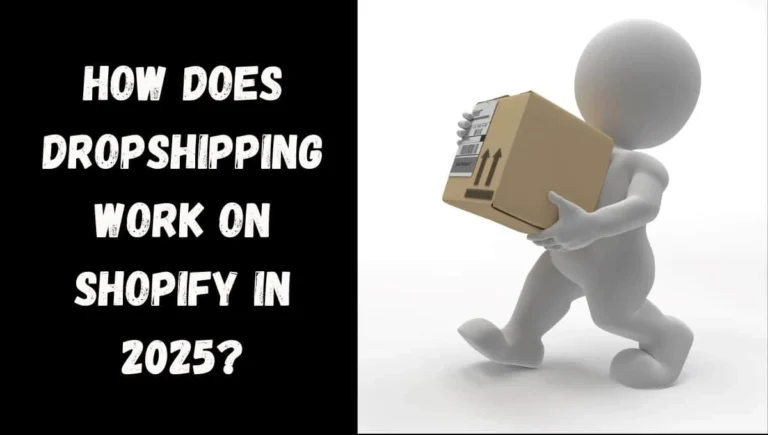Introduction
Dropshipping has revolutionized the way people start and run online businesses. With its low upfront costs and minimal risk, it has become a popular choice for entrepreneurs worldwide. Shopify, one of the leading e-commerce platforms, has played a significant role in making dropshipping accessible to everyone. But how exactly does dropshipping work on Shopify? In this blog, we’ll break down the process step by step, explore the benefits and challenges, and provide actionable tips to help you succeed in the competitive world of dropshipping.
Table of Contents
Learn more about Will Dropshipping Be Profitable in 2025?
What is Dropshipping?

Dropshipping is a unique business model where dropshipper sell products to customers without holding any inventory. Instead, when a customer places an order on your online store, you purchase the product from a third-party supplier who then ships it directly to the customer. This means you don’t have to worry about storing, packaging, or shipping products yourself.
Key Characteristics of Dropshipping:
- No Inventory Management: You don’t need to worry about storing, packaging, or shipping products.
- Low Startup Costs: Since you don’t need to invest in inventory, the initial costs are significantly lower compared to traditional retail.
- Flexibility: You can operate your business from anywhere.
How It Differs from Traditional Retail:
In traditional retail, businesses purchase bulk inventory, store it in a warehouse, and ship products to customers as orders come in. This requires significant upfront investment and ongoing management. Dropshipping eliminates these challenges, making it an attractive option for new entrepreneurs.
Why Choose Shopify for Dropshipping?
Shopify is a powerful e-commerce platform that simplifies the process of setting up and managing an online store. Here’s why it’s a top choice for dropshipping:
Key Features of Shopify:
- User-Friendly Interface: Shopify is designed for beginners, with an intuitive dashboard and easy-to-use tools.
- App Integrations: The Shopify App Store offers a wide range of apps, including dropshipping-specific tools like Oberlo, Spocket, and DSers.
- Scalability: Whether you’re just starting or running a high-volume store, Shopify can scale with your business.
- Reliable Hosting: Shopify provides secure and fast hosting, ensuring your store runs smoothly.
Comparison with Other Platforms:
While platforms like WooCommerce and BigCommerce also support dropshipping, Shopify stands out for its simplicity, extensive app ecosystem, and dedicated support.
How Does Dropshipping Work on Shopify?

Let’s dive into the step-by-step process of setting up and running a dropshipping business on Shopify.
Step 1: Setting Up a Shopify Store
- Create an Account: Sign up on Shopify’s website for an account. You’ll need to provide basic information like your email address, store name, and business details.
- Choose a Theme: Choose a theme from the library of Shopify. Its available in free and paid. Select one that aligns with your brand and customize it to create a professional-looking store.
- Set Up Essential Pages: Create pages like “About Us,” “Contact Us,” and “Shipping Policy” to build trust with your customers.
Step 2: Finding a Dropshipping Supplier
- Use Dropshipping Apps: Apps like Oberlo, Spocket, and DSers allow you to connect with suppliers and import products directly to your store.
- Research Suppliers: Look for suppliers with good reviews, reliable shipping times, and quality products. AliExpress and SaleHoo are popular platform.
- Vet Suppliers: Contact suppliers to confirm their reliability, product quality, and shipping policies.
Step 3: Adding Products to Your Store
- Import Products: Use your chosen dropshipping app to import products from suppliers.
- Optimize Product Listings: Write compelling product titles and descriptions, use high-quality images, and set competitive prices.
- Organize Products: Categorize products into collections to make it easier for customers to navigate your store.
Step 4: Setting Up Payment and Shipping Options
- Configure Payment Gateways: Shopify supports multiple payment options, including credit cards, PayPal, and Shopify Payments. Choose the ones that work best for your target audience.
- Set Up Shipping Rates: Decide whether to offer free shipping, flat rates, or real-time carrier rates. Be transparent about shipping times to manage customer expectations.
Step 5: Marketing Your Store
- Leverage Social Media: Use platforms like Instagram, Facebook, and TikTok to promote your products and engage with your audience.
- Invest in SEO: Optimize your store for search engines by using relevant keywords, creating blog content, and building backlinks.
- Run Paid Ads: Use Google Ads or Facebook Ads to drive targeted traffic to your store.
- Build a Brand: Focus on creating a unique brand identity that resonates with your target audience.
Step 6: Processing Orders
- Receive Orders: When a customer places an order, you’ll receive a notification in your Shopify dashboard.
- Place Orders with Suppliers: Use your dropshipping app to place the order with your supplier. Provide the customer’s shipping details.
- Track Shipments: Monitor the shipment status and keep your customer informed about delivery times.
- Handle Customer Service: Address any issues or concerns your customers may have, such as delayed shipments or damaged products.
Pros and Cons of Dropshipping on Shopify
Pros:
- Low Upfront Investment: You don’t need to purchase inventory upfront, making it affordable to start.
- Easy to Scale: As your business grows, you can add more products and suppliers without significant additional costs.
- Wide Product Range: You can offer a variety of products without holding inventory.
- Flexibility: Run your business from anywhere and manage it on your own schedule.
Cons:
- Lower Profit Margins: Since you’re not buying in bulk, your profit margins may be lower compared to traditional retail.
- Dependency on Suppliers: Your reputation depends on your suppliers’ reliability and product quality.
- Shipping Challenges: Longer shipping times and potential delays can lead to customer dissatisfaction.
- Competition: Dropshipping is a popular business model, so you’ll face stiff competition in many niches.
Tips for Success in Shopify Dropshipping

1. Choose a Profitable Niche
- Focus on a right niche with low competition but high demand.
- Research trending products and customer preferences.
2. Focus on Customer Service
- Resolve issues of customer quickly & respond the customer inquiries.
- Offer hassle-free returns and refunds to build trust.
3. Optimize Your Store
- Ensure your store is mobile-friendly and loads quickly.
- Use high-quality images and compelling product descriptions.
4. Invest in Marketing
- Analyze the different marketing strategies to find what works best for your store.
- Use email marketing to connect with your customers.
5. Monitor Competitors
- Keep an eye on your competitors’ pricing, products, and marketing strategies.
- Identify gaps in the market and capitalize on them.
Common Mistakes to Avoid in Shopify Dropshipping
1. Not Researching Suppliers
- Failing to vet suppliers can lead to poor product quality and shipping delays.
- Always read reviews and test products before adding them to your store.
2. Overlooking Branding
- strong brand identity is important to stand out in a competitive market.
- Invest in a professional logo, consistent branding, and a unique value proposition.
3. Ignoring Customer Feedback
- Customer reviews and feedback provide valuable insights into areas for improvement.
- Use feedback to refine your product offerings and customer service.
4. Failing to Monitor Competitors
- Ignoring your competitors can leave you behind in the market.
- Stay updated on trends and make your strategies accordingly.
Conclusion
Dropshipping on Shopify offers a low-risk, high-reward opportunity for aspiring entrepreneurs. By understanding how the process works and following best practices, you can build a successful dropshipping business. While challenges like competition and supplier dependency exist, the right strategies and mindset can help you overcome them.
If you’re ready to take the plunge, start by setting up your Shopify store, finding reliable suppliers, and marketing your products effectively. With dedication and persistence, you can turn your dropshipping venture into a thriving online business.
Have questions or thoughts about dropshipping on Shopify? Share them in the comments below!
Frequently Asked Questions
Why is Shopify a good platform for dropshipping?
Shopify is a popular choice for dropshipping because of its user-friendly interface, extensive app integrations, and scalability. It offers tools like Oberlo, Spocket, and DSers, which make it easy to connect with suppliers and manage your store. Additionally, Shopify provides reliable hosting, secure payment options, and customizable themes, making it ideal for both beginners and experienced entrepreneurs.
Do I need technical skills to start dropshipping on Shopify?
No, you don’t need advanced technical skills to start dropshipping on Shopify. The platform is designed for beginners, with an intuitive dashboard and step-by-step guides to help you set up your store. Apps like Oberlo simplify product sourcing and order fulfillment, so you can focus on growing your business.
How much does it cost to start a dropshipping business on Shopify?
The cost of starting a dropshipping business on Shopify varies, but here’s a breakdown of the main expenses:
Shopify Subscription: Plans start at $29/month.
Domain Name: Around 10
−10−20/year.
Apps and Tools: Some dropshipping apps are free, while others have monthly fees.
Marketing: Budget for social media ads, SEO, or influencer collaborations.
Overall, you can start with as little as 100
−100−200, making dropshipping one of the most affordable business models.
How do I find reliable suppliers for my Shopify store?
You can find reliable suppliers through:
Dropshipping Apps: Oberlo, Spocket, and DSers connect you with vetted suppliers.
Supplier Directories: Platforms like AliExpress, SaleHoo, and Worldwide Brands list thousands of suppliers.
Research: Read reviews, check shipping times, and order samples to test product quality before adding them to your store.
Can I sell any product through dropshipping on Shopify?
While you can technically sell any product, it’s important to choose products that are in demand, have good profit margins, and align with your target audience. Avoid restricted or copyrighted products, as they can lead to legal issues. Research your niche thoroughly to find products that will sell well.
How do I market my Shopify dropshipping store?
Effective marketing strategies for dropshipping include:
Social Media Marketing: Promote your products on platforms like Instagram, Facebook, and TikTok.
Search Engine Optimization (SEO): Optimize your store for search engines to attract organic traffic.
Paid Advertising: Run Google Ads or Facebook Ads to target specific audiences.
Email Marketing: Build an email list and send newsletters, promotions, and updates to engage customers.
What are the biggest challenges of dropshipping on Shopify?
Some common challenges include:
Lower Profit Margins: Since you’re not buying in bulk, your margins may be smaller.
Supplier Dependency: Your reputation depends on your supplier’s reliability and product quality.
Shipping Delays: Longer shipping times can lead to customer dissatisfaction.
Competition: Dropshipping is a popular business model, so standing out can be difficult.
Can I use multiple suppliers for my Shopify dropshipping store?
Yes, you can work with multiple suppliers to offer a wider range of products. However, managing multiple suppliers can be challenging, so it’s important to stay organized. Use apps like DSers to streamline order management and ensure smooth operations.
How do I scale my dropshipping business on Shopify?
To scale your dropshipping business:
Expand your product range based on customer demand.
Invest in marketing to drive more traffic to your store.
Optimize your store for conversions by improving product pages and checkout processes.
Consider outsourcing tasks like customer service or marketing to focus on growth.
Is dropshipping on Shopify profitable?
Dropshipping can be profitable if you choose the right niche, source high-quality products, and implement effective marketing strategies. However, success requires time, effort, and continuous optimization. Focus on building a strong brand and providing excellent customer service to maximize profitability.


1 thought on “How Does Dropshipping Work on Shopify in 2025?”